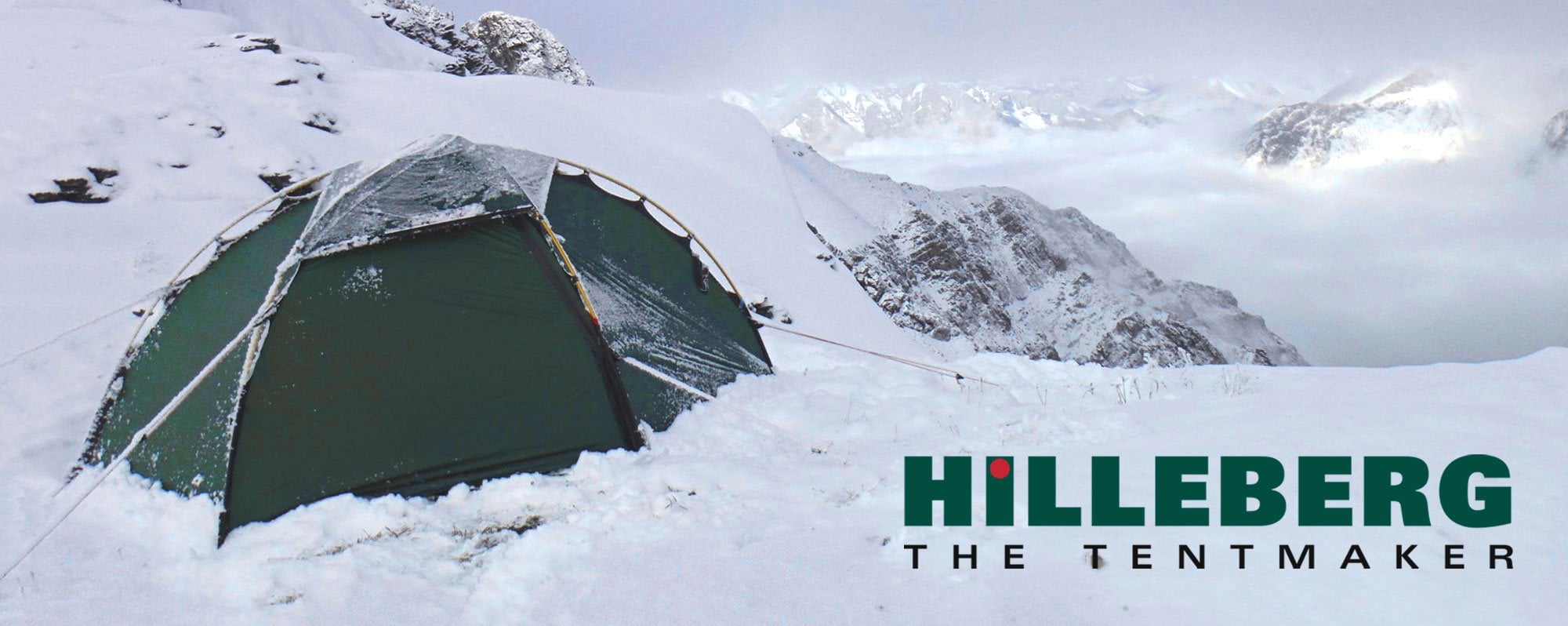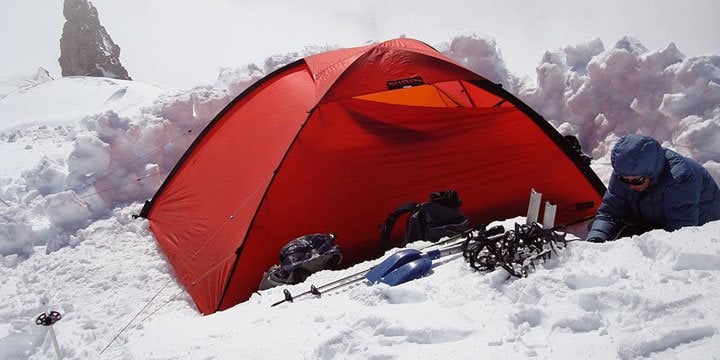Hilleberg Tent Labels
Feb 25, 2019

Hilleberg is a well established tent manufacturer, renowned for quality and durability across the world. Here at Ultralight Outdoor Gear we have had the pleasure of selling and reviewing Hilleberg tents for a few years now and we have expanded the range of tents we stock each year. Hilleberg have been producing tents for well over 40 years now and their history and heritage is an important part of the company.
To outline a tent’s capabilities, we use our Label categories: Black Label models are all season, all condition tents ideal for any user; Red Label tents are all season models that favour light weight over absolute strength; tents in the Yellow Label group prioritize the lightest weight, and are geared for warmer climates and for use in snow-free times and in more protected conditions; and Blue Label models are individually task specific. Our performance “principles” – the six attributes we consider critical to superior performance – are reliability, adaptability, ease of use, durability, and comfort, all integrated into the optimal synthesis for the intended performance range, at an appropriately low weight.

Our most versatile tents, Black Label models will handle any terrain or weather condition, from the mildest to the most demanding. Their simplicity, ease of use, and comfort make them perfect not only for any trip in any season, but also for general use in less challenging situations, and for less experienced users. Their strength, stability, and roominess, meanwhile, make them the best choice for long term, demanding, all season use in the harshest conditions – exposed and/or above tree line terrain, continuous heavy snow conditions, high-grit environments like deserts, beaches, and playas, and the like. Their extra durability increases longevity, and reduces the risk of problems, especially on longer adventures in remote areas, where repair opportunities may be limited.
Black Label tents are constructed with our strongest materials:
- Outer tent in our Kerlon 1800 fabric, with an 18 kg/40 lb tear strength
- 10 mm poles
- 3 mm Vectran & polyester guy lines. Our most robust inner tent and floor fabrics
- Heavier duty zippers
- Y-Pegs, our strongest pegs




Red Label tents are built for both short and longer trips in generally less demanding conditions in all seasons, such as less exposed mountain terrain, forests in both winter and summer, and the like, but where you still may encounter severe situations. Their emphasis on lighter weight makes them less than ideal for harsh environments and extended adventures in demanding conditions. They are, however, quite capable of withstanding heavy storm conditions. Experienced users sometimes choose these tents for more demanding adventures because they knowingly accept the trade-off of strength for lighter weight.
Red Label tents' materials favour lighter weight over absolute strength:
- Our Kerlon 1200 outer tent fabric, which has a 12 kg/26.5 lb tear strength
- 9 mm poles
- 3 mm Vectran & polyester guy lines
- Lighter weight inner tent and floor fabrics
- Lighter weight zippers
- V-Pegs, our lighter, but still very strong, pegs


We engineer our Yellow Label tents principally to be lightweight. Intended for use in warmer climates and in snow-free conditions, these models have inner tents with large mesh panels which cannot be covered, and shorter outer tent walls. This ensures they have superb warm-weather venting, but can also make them feel cold in cooler conditions. Yellow Label models are perfect for long or short trips in more protected terrain, but, while they do have remarkable strength, their lighter weight materials and their design make them less than ideal for fully exposed or high altitude terrain or remote adventures.
Yellow Label tents are constructed with our lightest materials:
- Our Kerlon 1000 outer tent fabric, with an 8 kg/17.6 lb tear strength
- 9mm poles. 2 mm guy lines. Our lightest inner tent and floor fabrics
- Lighter weight zippers
- Outer tent does not go all the way to the ground, offering a lightweight balance of weather protection and constant air flow. Different length poles reduce weight. Large, fixed mesh panels on the inner tent and shorter outer tent walls create constant cooling air flow (which can feel cold in cooler conditions). The interior is designed to maximize light weight while providing sufficient roominess.


Hilleberg build tents and backcountry shelters. That’s all we do, and from our first tent in 1973, we have been driven by a single, simple point of reference: define the capabilities of the tent or shelter we envision, then build it with the most advantageous balance of six essential principles for its desired performance. We believe this method of design and construction yields the highest performing backcountry shelter solutions available.
To outline a tent’s capabilities, we use our Label categories: Black Label models are all season, all condition tents ideal for any user; Red Label tents are all season models that favour light weight over absolute strength; tents in the Yellow Label group prioritize the lightest weight, and are geared for warmer climates and for use in snow-free times and in more protected conditions; and Blue Label models are individually task specific. Our performance “principles” – the six attributes we consider critical to superior performance – are reliability, adaptability, ease of use, durability, and comfort, all integrated into the optimal synthesis for the intended performance range, at an appropriately low weight.
Thus, Black Label models offer the highest level of these qualities. Since lighter weight is given higher priority in the Red and especially in the Yellow Label performance blends, there is some sacrifice of reliability, adaptability, ease of use and so on in these groups.
Our ultimate aim is not to make the lightest tents, but, within their performance range, the lightest, strongest, most reliable, dependable, comfortable and durable ones.
- Reliability - Simply put, you must be able to depend on your Hilleberg tent, whether it’s one of our strongest, Black Label models, or one of our lightest, most minimal Yellow Label ones. We deliberately choose all materials, design elements and construction techniques – outer tent fabrics, pole diameter and guy line placement, for example – to exceed the performance parameters in each Label category.
- Adaptability - Your Hilleberg tent must perform equally well across the entire spectrum of its Label category performance range. Thus, Black and Red Label tents must be true all-season ones. Specifically, Black Label models must be fully functional in both the most and least demanding conditions. Red Label tents must be nearly as adaptable, but with the constraint of their prioritizing lighter weight over absolute strength. Yellow Label tents, designed for warmer environments and for snow free trips in less exposed terrain, must still adapt to hot or cool, rainy or dry, and windy or still conditions.
- Ease of Use - No matter how reliable a backcountry shelter is, if it’s complicated or difficult to put up, it plainly falls short. Every Hilleberg tent features linked inner and outer tents, which provides simultaneous pitching of both as well as the inherent simplicity that allows for simple, straightforward set-up, even in bad weather. For our Black and Red Label models, that means being able to pitch the tents easily, even in high winds and blowing snow, in the dark, alone, and while wearing heavy gloves. Our Yellow Label models, similarly, must be as uncomplicated to set up, by one person, at night, in rainy, blustery conditions as they are in calm ones.
- Durability - Given its performance range of use, your tent must be able to withstand not only the daily rigors of your trips, but it must also last as long as possible. Our Black Label tents are designed and built to offer the greatest durability. Red Label and Yellow Label models are made to give the best durability possible given their lighter weight materials. At the same time, we are very conservative, so we over-test and understate the specifications of all of our tents.
- Comfort - Comfort in the backcountry is not mere “luxury”; it’s basic “livability.” That’s why all Hilleberg tents are built with bright, spacious interiors and venting solutions that keep air flowing in all weathers. It is also why all our tents have the small details that turn a mere house into a home: well-placed interior gear pockets; clothes lines; and appropriately placed ring and toggle or clip and loop fasteners for open doors or vents.
- Low Weight - Making a reliable, adaptable and easy-to-pitch tent that is heavy doesn’t meet our standards. But neither does creating a tent that is super light at the expense of any of our other criteria. The key to our low weight principle is that we never consider the weight an end in itself, but as the mortar that binds our other criteria together. The development of both our lightweight Kerlon 1200 for Red Label tents and our even lighter Kerlon 1000 for Yellow Label tents produced a number of choices. In both cases, we opted for the ones that best-balanced light weight and strength. We could have chosen a lighter fabric, but it simply would not have met our standards.
